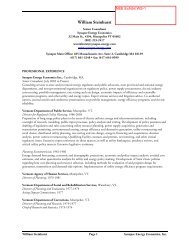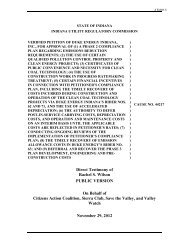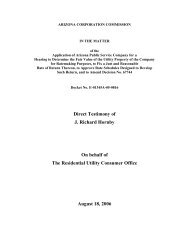Best Practices in Energy Efficiency Program Screening - Synapse ...
Best Practices in Energy Efficiency Program Screening - Synapse ...
Best Practices in Energy Efficiency Program Screening - Synapse ...
Create successful ePaper yourself
Turn your PDF publications into a flip-book with our unique Google optimized e-Paper software.
widely accepted as represent<strong>in</strong>g low-risk <strong>in</strong>vestments, is straightforward, is transparent<br />
and is readily available. It also means that different utilities <strong>in</strong> a s<strong>in</strong>gle state will use the<br />
same discount rates across the state, as it elim<strong>in</strong>ates the need to develop utility-specific<br />
risk-adjusted discount rates.<br />
Discount Rate for the Participant Test<br />
The Participant Test considers whether an energy efficiency <strong>in</strong>vestment is cost effective<br />
from the program participant’s po<strong>in</strong>t of view. This test should be used pr<strong>in</strong>cipally to set<br />
an <strong>in</strong>centive level that would be sufficient to make consumers implement efficiency<br />
measures. A consumer’s discount rate should be used to discount the costs and benefits<br />
<strong>in</strong> this test.<br />
However, choos<strong>in</strong>g a consumer’s discount rate is adm<strong>in</strong>istratively and theoretically<br />
complicated as different customers have different discount rates. There is considerable<br />
uncerta<strong>in</strong>ty over what the reference po<strong>in</strong>t should be, as some consumers have home<br />
equity credit available, but some only have access to credit card type debt with a much<br />
higher cost.<br />
For residential customers, energy efficiency programs are generally of lower risk than<br />
almost any <strong>in</strong>vestment the household can make, but immediate needs tend to put<br />
pressure on household capital, mak<strong>in</strong>g borrow<strong>in</strong>g rates also a factor. These po<strong>in</strong>ts<br />
suggest that home equity loan or home mortgage rates might be appropriate, especially<br />
<strong>in</strong> new construction and remodel<strong>in</strong>g programs, with higher credit card rates be<strong>in</strong>g more<br />
applicable to participants <strong>in</strong> low <strong>in</strong>come programs.<br />
For commercial and <strong>in</strong>dustrial customers, a reasonable cost of borrow<strong>in</strong>g proxy could be<br />
local commercial lend<strong>in</strong>g rates or a prime rate plus an adder for non-prime bus<strong>in</strong>esses,<br />
e.g., a prime rate plus three percent. For large entities with <strong>in</strong>ternal capital ration<strong>in</strong>g, it<br />
would be appropriate to use the firm’s <strong>in</strong>ternal rate of return hurdle rate or its <strong>in</strong>ternal<br />
payback requirement.<br />
Discount Rate for the RIM Test<br />
Discount<strong>in</strong>g is a side issue for the RIM test because the key goal of this test is to<br />
<strong>in</strong>dicate the effect of energy efficiency programs on retail rates. The utility WACC may<br />
be appropriate for this purpose because this is the borrow<strong>in</strong>g cost that ultimately<br />
determ<strong>in</strong>es utility rates.<br />
Illustrative Example<br />
Figure 5.1 summarizes the impact on program cost-effectiveness when us<strong>in</strong>g different<br />
discount rates. The blue bars present program cost-effectiveness us<strong>in</strong>g a nom<strong>in</strong>al<br />
discount rate of 3.2 percent, which is our example utility’s actual discount rate for energy<br />
efficiency screen<strong>in</strong>g, based on 10-year US Treasury Bills. The red bars represent<br />
program cost-effectiveness us<strong>in</strong>g a high discount rate of 8.5 percent, roughly equal to a<br />
utility’s after-tax WACC.<br />
This figure illustrates that a higher discount rate will reduce program cost-effectiveness,<br />
especially for programs with longer measure lives. As discussed above, the new<br />
construction programs typically have longer measure lives than other energy efficiency<br />
programs, and so discount<strong>in</strong>g the sav<strong>in</strong>gs from such programs at a higher rate will have<br />
<strong>Best</strong> <strong>Practices</strong> <strong>in</strong> <strong>Energy</strong> <strong>Efficiency</strong> <strong>Program</strong> Screen<strong>in</strong>g | www.nhpci.org | 53







